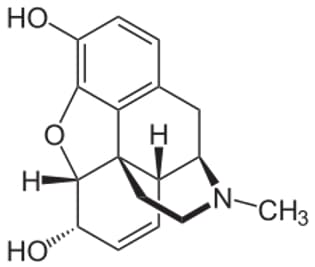Opioids and the Human Body:
Receptors evolved in the human body to recognize Endogenous Opioids. These are chemicals produced naturally to help regulate pain after injuries or in highly stressful situations. Our bodies release naturally occurring endogenous opioids in the form of neurotransmitters, like endorphins.
Opioid Receptors like the µ (MU) Opioid Peptide Receptor, are found spread throughout the body. When someone is injured the brain releases these endogenous opioids, which bind to the receptors and dull pain signals sent to the brain, increasing the chance of survival.
Physiological Response of Heroin:
Heroin and other synthetic opioids mimic these naturally occurring chemicals and bind to the same receptors. Because recreational use creates much higher concentrations of the chemical in the body the effects are intensified. As inhibitory chemicals, heroin and other opioids block pain signals from passing though the nervous system. This contributes to the euphoric sensations of the drug.
Simultaneously in the brain, upon binding to the receptors, heroin stimulates the ventral tegmental area, located in the midbrain. Due to this activation of the reward pathway, neurons release high quantities of the neurotransmitter dopamine, into the nucleus accumbens, which connects to the cerebral cortex.
Dopamine is (of course) linked to all compulsive and addictive behaviors and its release indicates high likelihood of behavior repetition. Research shows the brain would normally send inhibitory chemicals such as GABA to stop production of dopamine, but inhibitory responses are blocked. This allows the neurons to excessively release dopamine into the space between brain cells where chemical transmission takes place (Synapse).
Psychological dependence is formed from overexciting this reward pathway and building an association between heroin use and the short-term rewards one experiences from the “high”. When this chemical change is repetitively reinforced in the human body, the mechanisms which maintain homeostasis are activated.
Downregulation occurs when our bodies adapt to this flood of previously highly regulated chemicals. As a result, the body stops producing them on its own.
As tolerance builds, more of the drug is needed to feel euphoric effects. Many people who repeatedly use heroin will eventually end up needing the drug to feel “normal”. Eventually the individual acquires such a high tolerance they are no longer be able to “get high” with quantities of the drug they can handle physically and financially.
When a person afflicted with opioid addiction abstains, the brain chemistry is thrown wildly out of balance. This is due to the absence of the dopamine, endorphins, and other biological chemicals which are no longer being made naturally. Additionally, dormant neurons whose transmissions were previously dulled or blocked start to send signals again. As a result, the body responds with withdrawal symptoms to signify there is an imbalance. Although these symptoms increase the likelihood of relapse, brain plasticity allows the mind to readjust over time. This readjustment can take several months, and some individuals may never regain the same level of cognitive functioning as before use.
If you are struggling with opioids addiction, contact us now. We’re here for you to help.

